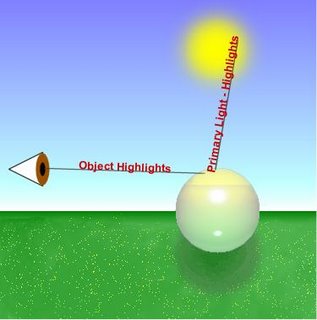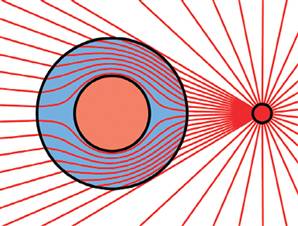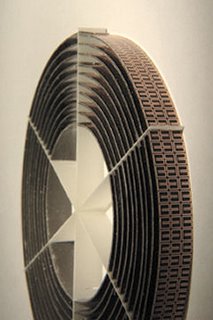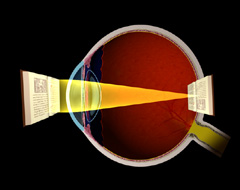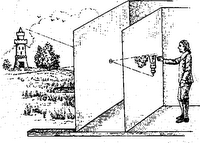 Recently I attended a show in Seattle called Bodies: The Exhibition. Complete, human, adult bodies have been skinned and imbued with silicone or polymeric plastic, in a process similar to fossilization. The chemicals replace bodily fluids down to the cellular level, preserving all details of the body. The plasticised corpses are clean, odor-free, completely detailed, and have cutaways so you can see the interior of muscles and organs. The bodies are on display for examination.
Recently I attended a show in Seattle called Bodies: The Exhibition. Complete, human, adult bodies have been skinned and imbued with silicone or polymeric plastic, in a process similar to fossilization. The chemicals replace bodily fluids down to the cellular level, preserving all details of the body. The plasticised corpses are clean, odor-free, completely detailed, and have cutaways so you can see the interior of muscles and organs. The bodies are on display for examination. It was an impressive and educational show. It forces you to adjust your mental ideas of what body parts are like. I was surprised, for example, at how thick the skin and fat layer is on a body. The belly button sticks out a good inch from the abdomen without that layer. I was surprised at how big the bladder is, how small the brain really is, how small the lungs are, the enormous number and complexity of blood vessels, how extremely long some neurons are, and so on. Plus, the displays are physically attractive. Artists would love them.
The show has appeared in Amsterdam, Miami, Las Vegas, and New York. There are other, similar exhibits traveling internationally, such as “Body Worlds.” The web site for the exhibit I saw is http://www.bodiestheexhibition.com/bodies.html
The controversy about the show is about where the bodies came from. Apparently there are no documents proving that the owners of the bodies had consented that their bodies could be used for medical purposes after they died.
Below: Nationalgeographic.com (Runner)
 “The bodies belonged to people from China who died unidentified or unclaimed by family members, said Dr. Roy Glover, a retired University of Michigan anatomy and cell biology professor and spokesman,” according to Graham and Duryea (2005). The Chinese government owns all unclaimed bodies, and often donates them to medical schools. The Dalian Medical University of Plastination Laboratories in the People's Republic of China is
“The bodies belonged to people from China who died unidentified or unclaimed by family members, said Dr. Roy Glover, a retired University of Michigan anatomy and cell biology professor and spokesman,” according to Graham and Duryea (2005). The Chinese government owns all unclaimed bodies, and often donates them to medical schools. The Dalian Medical University of Plastination Laboratories in the People's Republic of China is
the source of the bodies in this exhibit. The owners of the Exhibit, a for-profit corporation based in Atlanta, leased the bodies from the university.
The spokesperson for the exhibit points out that lack of written consent is not necessarily illegal or unethical.
“In some states, if a person dies and can't be identified by a medical examiner or family member, local university medical schools have an opportunity to receive the remains for study.”
Below: Times photo: Melissa Lyttle (Blood vessels in the hand)
Those are all accurate facts, as near as I can determine. So what is the basis of the controversy over the exhibit? Many objections have been raised but only two, it seems to me, are legitimate, and both of them are weak.
over the exhibit? Many objections have been raised but only two, it seems to me, are legitimate, and both of them are weak.
One argument is about money. Some big bucks are involved here. The organizer of the Bodies exhibit paid $25 million to rent the corpses and they expect to make all that back and more. We don’t know if Dalian Medical University paid the Chinese government for the bodies, but on the assumptions that nothing happens without money, especially in China, and that human beings will do anything for money, and knowing that the Chinese government does not have a strong record on human rights … assuming the worst, a reasonable person might worry that these bodies were “harvested” from among the living, by the government, as a cash crop. If so, an ethical person would not want to endorse such behavior nor further it, by paying the hefty admission fee ($27.50 per person in Seattle).
This is a legitimate, but weak objection because it is based on a whole set of presumptions about how the bodies were acquired. We simply do not know the facts. Furthermore the bodies did not appear to be traumatized (e.g., no gunshot wounds to the head or broken bones). It is a little odd that they are so young (I would guess 25 to 50) and apparently were in rude health, suggesting they did not die of a wasting disease or violence. But again, we just don’t know how they died and we have nothing to back up the mere suspicion of foul play. I admit it would have been better to have signed medical donation consent forms on public view.
Remaining Photos: Karen Ducey/Seattle Post-Intelligencer
 The second objection is cultural. In some cultures traditional people believe that a person’s soul is disturbed if the bodily remains are disturbed. I don’t know if that is true of traditional Chinese culture, but let’s assume it is. In that case, it could be considered culturally insensitive to display Chinese bodies in this manner (even though the bodies came from the Chinese government itself).
The second objection is cultural. In some cultures traditional people believe that a person’s soul is disturbed if the bodily remains are disturbed. I don’t know if that is true of traditional Chinese culture, but let’s assume it is. In that case, it could be considered culturally insensitive to display Chinese bodies in this manner (even though the bodies came from the Chinese government itself).
 Other objections voiced by protestors are less cogent.
Other objections voiced by protestors are less cogent.
“We don't know their names, or if they mind our stares.”
Not knowing the names of the prior owners of these corpses is not an ethical or legal issue. They obviously represent “the human body,” not named personalities.
We can be sure that the corpses do not mind our stares, because these are dead bodies, not people.
“These people would not have approved of how science is using their bodies.”
We don’t know that. In any case, it doesn’t matter to them now because these are dead bodies, not people.
“The displays desecrate the human body for profit.”
You can desecrate a temple or a holy image. Desecration is the violation of the sacred nature of something. But in modern medical science, the human body is not holy or sacred. It is a biological machine, especially after it is dead. So for a modern, scientifically minded person, this exhibit desecrates nothing.
The fact that the exhibit is a for-profit enterprise is not relevant to anything.
“This treatment of a body condemns the soul to wander the netherworld with no chance to rest.”
That is a particular cultural belief, but not one embraced by the organizers or viewers of this medically oriented exhibit. A person who has such concerns about other people’s souls should not see the exhibit.
"I know I wouldn’t want to be somebody's Saturday entertainment."
There’s nothing to worry about there, because the ‘I’ referred to in that objection would no longer exist, because these are dead bodies, not people. No serious person could believe that socially-aware consciousness would continue to inhabit their dead, plasticized body.
"The display is not honoring the dead and not treating them with dignity.”
It makes sense to honor the memory of the dead, but to a scientifically educated person, it does not make sense to honor a dead body.
 As to whether the bodies are treated with dignity, I believe they are. The exhibit is a completely serious educational presentation. There are no profane, vulgar, obscene, or undignified displays in it.
As to whether the bodies are treated with dignity, I believe they are. The exhibit is a completely serious educational presentation. There are no profane, vulgar, obscene, or undignified displays in it.
My feeling is that most objections to this exhibit stem from an unacknowledged denial of death. They seem to be based on the idea that somehow, the dead are not really dead, but still alive in some unexplained sense, and even still inhabit their dead, plasticized bodies. That is not a well thought-out basis for objection.
My unanswered question is, how can a modern, educated, rational person deny death in this way? It is utterly perplexing.
References:
Benedetti, W. (2006). Education or freak show? 'Bodies The Exhibition' cashes in on our own curiosity. Seattle P-I, 28 September 2006. (Online at http://seattlepi.nwsource.com/lifestyle/286689_bodies28.html )
Graham, K., and Duryea, B. (2005). Who is running man? St. Petersburg Times Tampa Bay, 28 July 2005. (Online at http://www.sptimes.com/2005/07/28/Tampabay/Who_is_running_man.shtml)






